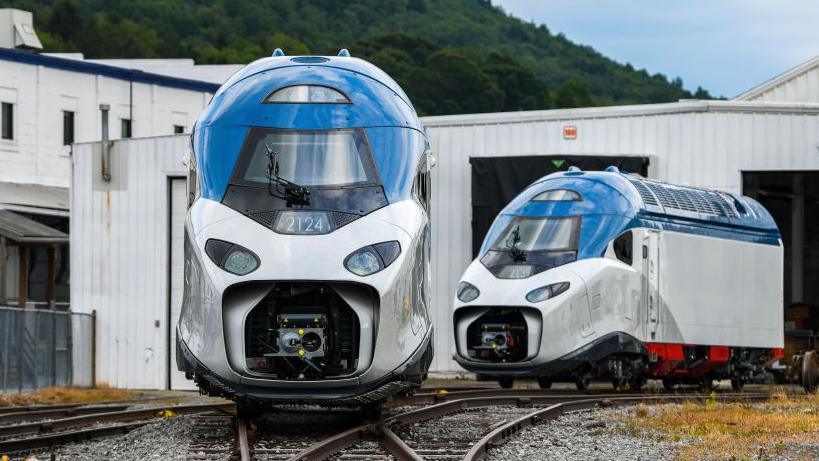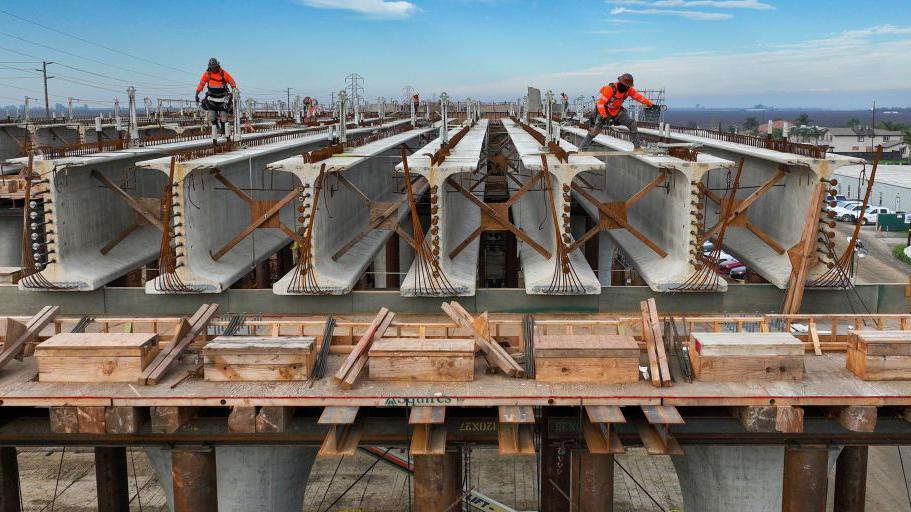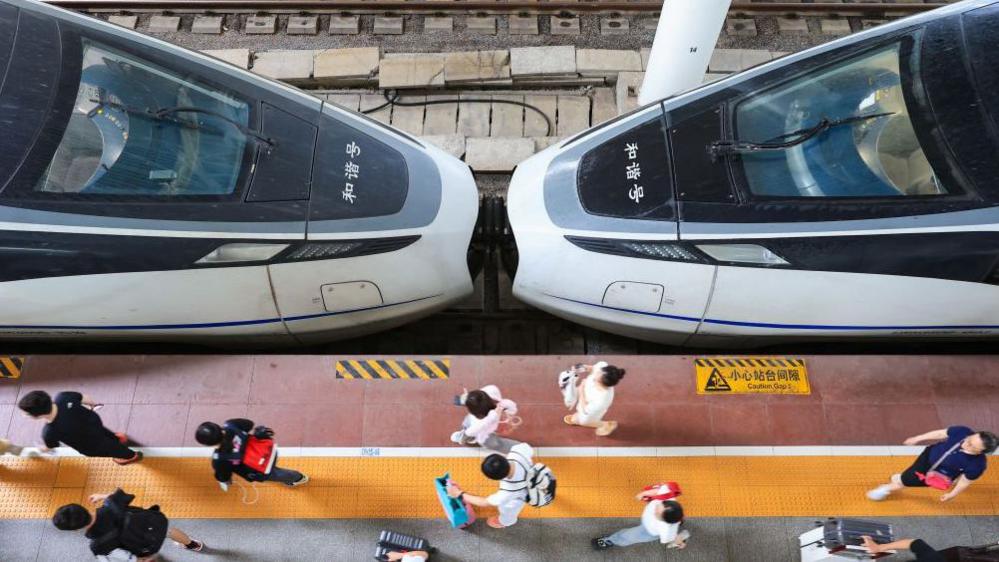Is the US finally on track to build a high-speed rail network?

Amtrak's new high-speed trains will be held back by tracks that greatly limit how quickly they can move
- Published
The US is a country of 340 million people, 71 interstate highways, more than 5,000 public airports, and currently no high-speed railways.
Yet with two high-speed rail (HSR) projects now under construction, and others planned, is the US finally on track to start catching up with the fast trains seen in China, Japan and Europe?
Rick Harnish, of US campaign group High Speed Rail Alliance, says it is at least good to see the first two schemes being built.
"The first is the San Francisco to Los Angeles route," he explains. "That's an incredibly challenging route to build because of the mountains in California.
"Then there's Las Vegas to Los Angeles, a relatively easy project to build, as it is flat land."
In addition, there are plans for a HSR line from Portland in Oregon to Seattle in Washington State, and onto Vancouver in Canada. And another between Dallas and Houston.
Yet Mr Harnish warns that planning efforts for the former are "moving slowly", while the Texas line is now more doubtful after President Trump's government cancelled a $63.9m (£48m) grant., external
By marked contrast, the total length of China's HSR network will reportedly exceed 50,000 km (31,000 miles), external this year.
Meanwhile, the European Union has 8,556 km, external of HSR lines, led by Spain's 3,190 km.
In the UK, the only current HSR line is High Speed 1, the 68 miles link between the Channel Tunnel and London St Pancras. But High Speed 2 continues to be constructed from London Euston to Birmingham, despite well-publicised funding issues.
While there is no universally agreed definition on what constitutes HSR, global railways trade group International Union of Railways says that trains generally need to be moving at more than 250 km/h (155 mph)., external
So why does US lag behind Europe and especially China?
"We're a very car-addicted nation," says American rail industry journalist and author Will Doig. "There's lots of people who just don't think we need it, or don't really want it coming through their area.
"And the US government has really shown a willingness to shut down investment in a lot of projects, especially rail."

Two high-speed rail lines are currently under construction in the US, in California and Nevada
Further complicating the situation in the US is that the boss of the government-owned passenger train service Amtrak, Stephen Gardner, resigned last month., external It was widely reported that he stood down after pressure from the White House.
Amtrak currently does not operate any HSR trains. Later this year it is due to enter 28 new 160mph NextGen Acela trains into service on its Northeast Corridor route between Boston and Washington DC. However, only around 50 miles of the 457-mile line can presently allow trains to travel at more than 150mph.
Amtrak is not involved in the high-speed lines being built in California and Nevada. The LA to San Francisco project, called California High-Speed Rail, is being led by the state of California, and due to be completed by 2033.
The line from Los Angeles to Las Vegas, Brightline West, is a privately-run project. It is expected to open in 2028.
Globally, there are 23 nations with HSR, according to Mr Harnish. His non-profit organisation has the sole mission of bringing it to the US.
Allowing HSR trains to run safely is far from straightforward, he adds. "You can't have any crossings with highways, it needs to be very straight and a sealed corridor."
In China the country is still building more and more HSR lines, with the total distance expected to reach around 60,000km by 2030., external
Chinese cities that get HSR links see their economies increase by 14.2%,, external according to data from Denmark-based think tank 21st Europe.
Chinese firms are also helping to build HSR systems in other Asian countries, such as Indonesia, Malaysia, Thailand and Vietnam.
Will Doig, who wrote a book called High-Speed Empire, Chinese Expansion, and the Future of Southeast Asia, says that China is not just interested in helping its neighbours improve their rail networks.
"It is a way of China spreading its influence across a region that it felt was geopolitically strategic," he says.
"In some of these cases, countries have taken out loans from China so that China can then build the railways." He warns that this may put them "in a position where they're beholden to China".

China's high-speed rail network now dwarfs that in all other countries
Europe's growing HSR network is testament to the continent's history of investing in its public infrastructure, says Kaave Pour from 21st Europe.
His think tank is now calling for further expansion of HSR, so that it connects most capitals and main cities in the EU, and those in the UK.
Mr Pour says that if the US wants to develop HSR it needs to start with a cultural shift, a move towards more public transport, and asking itself "what type of future does it want?".
Mr Harnish from the High Speed Rail Alliance says that in order for HSR to work in the US, "the federal government is an essential component".
Yet as already flagged, the White House has pulled the plug on giving the planned high-speed line between Houston and Dallas a federal grant. US Transportation Secretary Sean Duffy described the project as a "waste of taxpayers' money"., external
Scott Sherin is an executive at French train manufacturer Alstom. His firm is suppling Amtrak's new high-speed trains, but he questions whether the US has the political will "to spend the public purse on rail versus other modes of transportation".
He also notes that any future HSR lines would struggle to get into city centres such as Dallas and Houston, because there are too many buildings. "The issue is that the cities are so densely built [in their centres]".
Will Doig says that going forward he would love to see China helping to build more HSR in the US, but that he is not holding his breath.
"It's politically very difficult," he says. "Which is too bad because without the animosity between the US and China, you could see how a partnership between them could really create great things for America, that America is not so good at building itself."